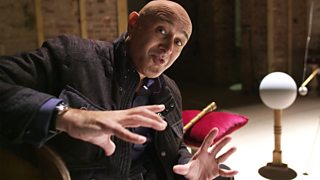Jim Al Khalili talks about his programme, 'Gravity: The Force That Shapes Our Lives'
Jon Jacob
Editor, About the Βι¶ΉΤΌΕΔ Blog

Jim Al Khalili returns to Βι¶ΉΤΌΕΔ Four tonight with a 90 minute feature-length documentary exploring some of the facts about gravity the rest of us might take for granted. We spoke to him to find out more about the programme, how he became a science broadcaster, and where in the UK is the best place to draw on the powers of gravity to help you lose weight.
How do you describe your presenting style Jim? How do you think you bring science alive on TV?
My traditional method is by being ‘Jim the Explainer’ - waving my hands about. To a large extent my documentaries don’t rely on CGI, or exotic locations, or elaborate analogies. Often they’re a simple location and a simple background. Everything is in my enthusiastic explanation. What drives me in science is finding out something new about how the universe works and then wanting to shout about it to everyone else. I derive as much pleasure seeing the moment of realisation in someone else’s eyes just as I enjoy that moment too.
When I transferred that into broadcasting on TV, I’m always imagining that one person sitting on the other side of the camera going “Wow”. It’s showing off – I feel I've been successful if the circuits have been blown in someone else’s brain.
How did you make the transition from teaching to broadcasting?
Younger people, science communicator academics who have that charisma – people come to them and say “I think you've got what it takes.” For me it was a slow process. It was never a plan. I’ve always enjoyed science – I’ve always enjoyed communicating science.
Most of my group of friends are non-scientists. So all of my adult life I’ve been used to explaining science. I’ve spent time looking for the right language and the right metaphors that suit that particular person. I’ve been used to not using jargon and painting pictures for people.
It gradually started 25 years ago through outreach and talks. I was the person my university colleagues always suggested when journalists were looking for a spokesperson. Then I started doing science festivals and people started spotting me at those and would ask me to be a contributor on a radio programme. And it was Paul Sen – the producer on "Gravity and Me: The Force That Shapes Our Lives’" – who was the first person I worked on a full length documentary with in 2007, a three-parter on the atom.
Tell us more about what we’ll learn in the programme? Is there much more to learn than what we already know?
The programme is not only a journey for me and the audience in explaining what gravity is and our understanding of it, but it’s also the road trip to discover where in the UK we weigh the least, and there’s the phone app which adds a little fun to proceedings and there’s even a twist at the end too. For me, there’s also a profound conclusion which prompted to go off and think about things a little more.
Albert Einstein realised that gravity is the result of the curvature of space and time. But why can’t we perceive this? Jim recounts an intriguing story Einstein told his son.
Is there a challenge for you as an expert to unlearn the things you know already in order for you to engage a new audience in what might be a new and challenging subject?
Some of the programmes I’ve made it can be like that. It can be a slightly artificial experience. You can’t fool the viewers – they have a fairly good idea what it is I know and what it is I don’t know. But although I know about the core facts to do with gravity – just as you would expect – this programme is seeing me learning about some unexpected and new things myself. As we show in the last twenty minutes of the film, there are some genuine surprises for me.
You mentioned that you found out where in the UK gravity is lightest. So, where should we avoid do you think?
Well it depends on whether you want it to be strongest or weakest. Where it’s weakest, that’s where you’re going to lose weight. It’s a combination of various things. For example, the earth bulges the closer you get to the equator. So, the closer you get to the equator the further away from the Earth's core you’ll get and the lighter you’ll become. Even just going north to south in the UK so the weaker the gravitational pull and the lighter you’ll become. You want to go as far south as possible.
On the other hand you want to go as high as you possibly can because that too will take you further away from the centre of the earth. So it’s a combination of factors and it turns out that if you go to the top of Mount Snowden you’re roughly the same distance from the centre of the earth as you are in the south of Scotland at sea level. But there’s a place which is the best of both worlds a little further south. You’ll have to watch the programme to find out where (and how much lighter you’ll be!)
Jon Jacob is Editor, About the Βι¶ΉΤΌΕΔ Blog
- ‘Gravity and Me: The Force That Shapes Our Lives’, Tuesday 28 March 2017, 9pm on Βι¶ΉΤΌΕΔ Four. The programme is available on Βι¶ΉΤΌΕΔ iPlayer for 30 days after broadcast.
